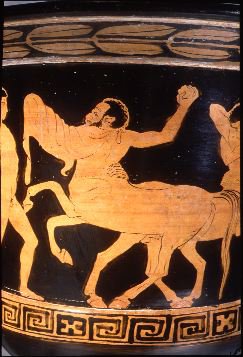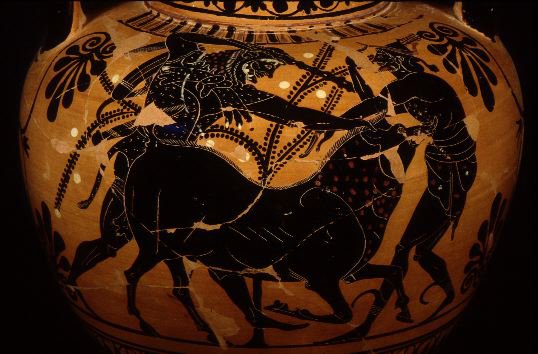The Erymanthian Boar
For the fourth labor, Eurystheus ordered Hercules to bring him the Erymanthian boar alive. Now, a boar is a huge, wild pig with a bad temper, and tusks growing out of its mouth.

Dewing 2440, silver stater from Lycia in Asia Minor, c. 520-500 B.C.
Obverse: the forepart of a boar.
Photograph by Maria Daniels, courtesy of the Dewing Numismatic Foundation
This one was called the Erymanthian boar, because it lived on a mountain called Erymanthus. Every day the boar would come crashing down from his lair on the mountain, attacking men and animals all over the countryside, gouging them with its tusks, and destroying everything in its path.

Malibu 86.AE.154, Attic black figure Siana cup, c. 580-570 B.C.
A boar hunt.
Collection of the J. Paul Getty Museum, Malibu, California
On his way to hunt the boar, Hercules stopped to visit his friend Pholus, who was a centaur and lived in a cave near Mount Erymanthus. Everyone knows that centaur is a human from his head to his waist, and a horse for the rest of his body and his legs. Hercules was hungry and thirsty, so the kindly centaur cooked Hercules some meat in the fireplace, while he himself ate his meat raw.

London B 226, Attic black figure neck amphora, c. 530-510 B.C.
Hercules and the centaur Pholos shaking hands.
Photograph courtesy of the Trustees of the British Museum, London
When Hercules asked for wine, Pholus said that he was afraid to open the wine jar, because it belonged to all the centaurs in common. But Hercules said not to worry, and opened it himself.
Soon afterwards, the rest of the centaurs smelled the wine and came to Pholus's cave. They were angry that someone was drinking all of their wine. The first two who dared to enter were armed with rocks and fir trees.

RISD 22.215, Apulian red figure calyx krater, c. 430-420 B.C.
A centaur holds a rock, poised to attack Hercules.
Photograph by Brooke Hammerle, courtesy of the Museum of Art, RISD, Providence, RI
Hercules grabbed burning sticks from the fireplace and threw them at the centaurs, then went after them with his club.

Malibu 88.AE.24, Attic black figure amphora, c. 530-520 B.C.
Hercules rauses his club, about to hit a centaur.
Collection of the J. Paul Getty Museum, Malibu, California
He shot arrows at the rest of them and chased after them for about twenty miles. The rest of the centaurs fled in different directions. One of the centaurs, Chiron, received a wound that no amount of medicine would heal...but what happened to Chiron is another story.
While Hercules was gone, Pholus pulled an arrow from the body of one of the dead centaurs. He wondered that so little a thing could kill such a big creature. Suddenly, the arrow slipped from his hand. It fell onto his foot and killed him on the spot. So when Hercules returned, he found Pholus dead. He buried his centaur friend, and proceeded to hunt the boar.
It wasn't too hard for Hercules to find the boar. He could hear the beast snorting and stomping as it rooted around for something to eat. Hercules chased the boar round and round the mountain, shouting as loud as he could. The boar, frightened and out of breath, hid in a thicket. Hercules poked his spear into the thicket and drove the exhausted animal into a deep patch of snow.

Harvard 1960.314, Attic black figure neck amphora, c. 510-500 B.C.
Hercules grabs the boar's head and raises his club to strike it. On the right, the god Hermes offers assistance.
Photograph by Maria Daniels, courtesy of Harvard University Art Museums
Then he trapped the boar in a net, and carried it all the way to Mycenae. Eurystheus, again amazed and frightened by the hero's powers, hid in his partly buried bronze jar.

Mississippi 1977.3.63, Attic black figure neck amphora, c. 540-520 B.C.
Hercules brings the boar to Eurstheus, carrying it on his shoulder. He rests his foot on the rim of the pithos, where Eurystheus cowers.
Photograph by Maria Daniels, courtesy of the University Museums, University of Mississippi
(wpm)
To read more about these topics, see Further Resources.
- Labor 1: The Nemean Lion
- Labor 2: The Lernean Hydra
- Labor 3: The Hind of Ceryneia
- Labor 4: The Erymanthean Boar
- Labor 5: The Augean Stables
- Labor 6: The Stymphalian Birds
- Labor 7: The Cretan Bull
- Labor 8: The Horses of Diomedes
- Labor 9: The Belt of Hippolyte
- Labor 10: Geryon's Cattle
- Labor 11: The Apples of the Hesperides
- Labor 12: Cerberus
This exhibit is a subset of materials from the Perseus Project digital library and is copyrighted. Please send us your comments.